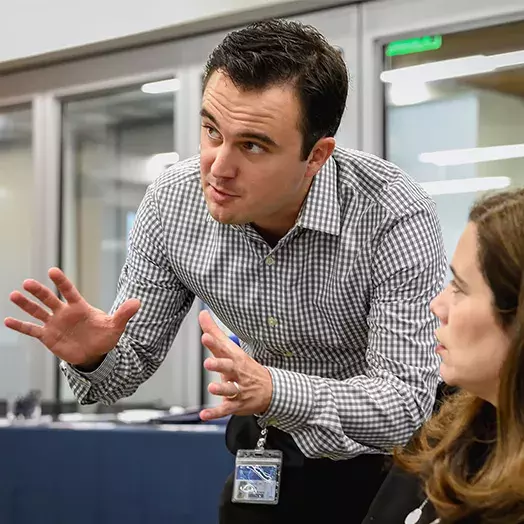Danielle Piccinini Black, academic lead for Johns Hopkins Executive Education’s Design Thinking for Innovation, discusses the benefits of utilizing design thinking as an empathy-centered approach to problem-solving.

Design thinking: problem-solving rooted in empathy
While volunteering with the Peace Corps in South Africa, Johns Hopkins Executive Education adjunct faculty member Danielle Piccinini Black (MBA/MPH ’16) experienced the complex challenges of creating effective and desirable solutions for global health initiatives.
Her time in South Africa inspired her to pursue an MPH/MBA dual degree from Johns Hopkins, confident that comprehensive public health and business skillsets would help create a niche for herself in the public health sector.
Today, Piccinini Black is the academic lead for Design Thinking for Innovation within Johns Hopkins Carey Business School’s Executive Education program. She also serves as an adjunct faculty member for design thinking courses at Carey, as well as the design innovation lead at Johns Hopkins Center for Communication Programs.
Her initial exposure to design thinking came during her time as an MBA student at Carey Business School. Now, an empathy-centered approach to problem-solving through design thinking is the basis of her career in both business and public health.
Post-graduation, Piccinini Black was hired at the Johns Hopkins Center for Communication Programs. Using her background in public health, she was brought onto a project to reinvigorate a commercial market for bed nets for malaria prevention in Ghana.
“This project was a great opportunity to apply the skills I gained in the design thinking course to a ‘real world’ project. I pitched the idea of using design thinking to design new bed nets for commercial sale and it stuck. That project was really the catalyst for my career,” she said.
Design thinking is a creative problem-solving process that’s rooted in empathy. By leveraging creativity, individuals can ultimately design and achieve novel solutions to complex problems and compete in today’s dynamic market.
“It’s a process to help create solutions that will actually meet the needs, desires, and constraints of its end users,” she said.
Piccinini Black leverages this human-centered mindset in the way she approaches and designs her design thinking research, workshops, and classes.
“I approach all my courses and design thinking work in an empathetic way. The design of my research processes and teaching approaches are rooted in a deep understanding of the participants, users, and key stakeholders,” she said. “I never conduct two processes or teach two courses the exact same way. It’s important to tailor each in order to respond to the realities of those involved.”
Breaking old habits
Piccinini Black says the pandemic created a space where organizations were forced to break out of old habits and become more creative in their approaches to problem-solving.
Looking for creative and effective approaches to problem-solving, working professionals from various industries are enrolling in Carey Business School’s Executive Education design thinking courses to help build their skillsets with hopes of bringing new, innovative solutions to their organizations. This approach to problem-solving can be leveraged for a variety of problems in different industries.
“Individuals want to revolutionize their problem-solving skills. Working professionals of all career levels participate in design thinking courses to better understand how to tackle business challenges and develop a more expansive human-centered mindset,” she said. “It is intended for individuals of different disciplines and backgrounds to learn how to solve complex problems in a more effective and strategic way.”
Piccinini Black explained that design thinking gives organizations a mechanism for engaging end users and key stakeholders at the beginning of and throughout the problem-solving process. And by doing so, it reduces risk and failure of not meeting the needs of stakeholders.
“Individuals leverage empathy, research, ideation, and iteration to devise novel, human-centered solutions. We collaborate with companies and organizations to bring ‘real world’ challenges to our courses, so participants learn design thinking through experiential learning,” she said.
“Working professionals of all career levels participate in design thinking courses to better understand how to tackle business challenges and develop a more expansive human-centered mindset.”
Danielle Piccinini Black
A promising future for design thinking
Piccinini Black has seen greater emphasis on design thinking approaches to problem-solving since the pandemic, giving her hope for the future of innovation and empathy-focused problem-solving and solutions.
“We have a global shared experience from the pandemic, which I believe has made people more empathetic. Design thinking is empathy-centric, and the process seems to resonate with people more now than ever. Because our world is ever-changing, as a society we recognize that we must challenge routines and solve problems while fostering an empathetic mindset,” she said.
While it may be challenging to apply design thinking effectively without study and practice, Piccinini Black says adopting a human-centered mindset is something individuals can do right away.
“Simply approach your work and problem-solving with empathy for a comprehensive understanding of those you are working with and designing for. The easiest way to do that is to simply engage in conversation from the beginning. Learn directly from them,” she said.
Those who are interested in building their knowledge and skills in design thinking, Piccinini Black says to explore the Johns Hopkins Executive Education certificate in Design Thinking for Innovation.
“Knowing design thinking is one thing. But knowing how to do design thinking effectively and having the confidence to implement it in your work and lives outside of the classroom is another. Earning a certificate will get you there.”


